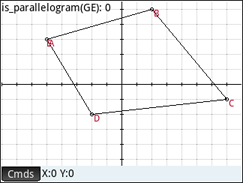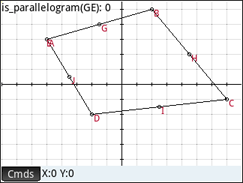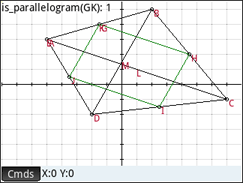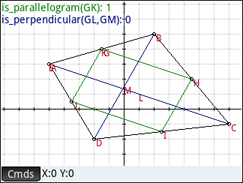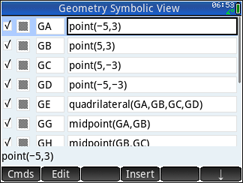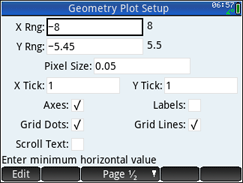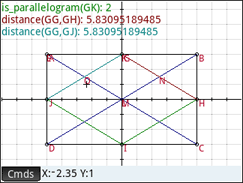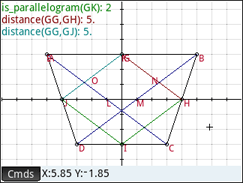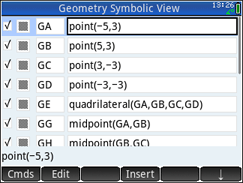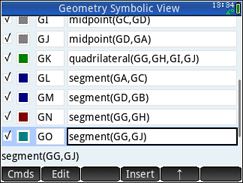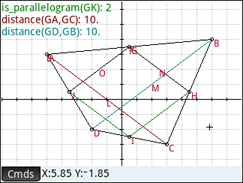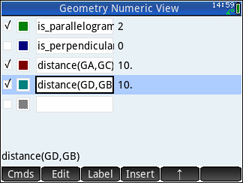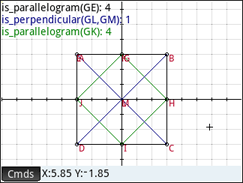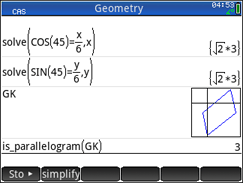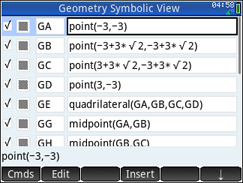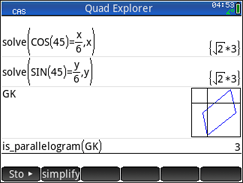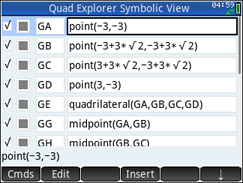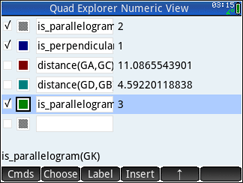Geometry > Exploring Quadrilaterals
Conjecture 1 | Conjecture 2 | Conjecture 3 | Conjecture 4 | Conjecture 5 | Conjecture 6
Exploring Quadrilaterals
See screen 4 With the testing and symbolic abilities of the Geometry app, we can prove or refute conjectures such as these:
1) If ABCD is a quadrilateral, then GHIJ is a parallelogram
2) If ABCD is a rectangle, then GHIJ is a rhombus
3) If ABCD is an isosceles trapezoid, then GHIJ is a rhombus
4) If the diagonals of ABCD are congruent, then GHIJ is a rhombus
5) If the diagonals of ABCD are perpendicular, then GHIJ is a rectangle
6) If ABCD is a rhombus, then GHIJ is a rectangle
(Workshop Material Version 1.3)
Press Apps key and select Geometry. Press the soft key Reset. Press Geometry again or soft key Start to begin.
The app comes up in the Plot view, the Geometry app’s drawing view. Use Cmds > 1 Zoom > 1 In.
Begin by constructing the quadrilateral on the left, screen 1. Use either Plot View Quadrilateral soft key Cmds menu or Geometry Symbolic View Point and Quadrilateral definitions.
Press the Num key to switch to the Geometry Numeric View. Select Cmds > 3 Tests > 8 Parallelogram. Use the soft key Vars to select GE. Check the definition's display box so that it will show on the Geometry Plot View screen. The number 0 signifies that the quadrilateral is not a parallelogram. Press the Plot key.
Add the midpoints, scrren 2. Use either Plot View Midpoint soft key Cmds menu or Geometry Symbolic View Midpoint definitions. If using the Geometry Symbolic View, press the Plot key.
Next add the midpoint’s quadrilateral, screen 3. Use either Plot View Quadrilateral soft key Cmds menu or Geometry Symbolic View Quadrilateral definition. Select the midpoint’s quadrilateral, use Options > 1 Choose Color > lower left’s green.
Press the Num key to switch to the Geometry Numeric View. Select Cmds > 3 Tests > 8 Parallelogram. Use the soft key Vars to select the midpoint quadrilateral. Check the definition's display box so that it will show on the Geometry Plot View screen. The number 1 signifies that the quadrilateral is only a parallelogram. Press the Plot key.
For the last addition add the diagonals, screen 4. Use either Plot View Segment soft key Cmds menu or Geometry Symbolic View Segment definition. If using the Geometry Symbolic View, press the Plot key.
Before proceeding with our conjecture, let us take a look at our current definitions. Press the Symb key, screen 5. Scroll to view the remaining entries, screen 6.
We need the next test for verification or refutation of our fifth conjecture. We are building a template of definitions and tests for a Quad Explorer App and thought the next test might provide some insight for the other quadrilateral conjectures.
Press the Num key to switch to the Geometry Numeric View. Select Cmds > 3 Tests > 8 Perpendicular. Use the soft key Vars to select the diagonals GL , GM.
At this point we add color to the tests and diagonals.. Use the Geometry Symbolic View and Geometry Numeric View color box field to set the blue and green colors shown in screen 7. Press the Plot key to show the colored drawing. Slide the drawing down to make it easier to read the tests result, screen 7.
We should note that our previous midpoint investigation showed that any convex, concave, and complex quadrilaterals midpoint quadrilateral is a parallelogram (assuming that the points A, B C, and D are not collinear).
Turning to a proof pf conjecture 1, if ABCD is a quadrilateral, then GHIJ is a parallelogram. We now prove the conjecture's convex quadrilateral case, screen 6.
Since segment GH joins the midpoints of two sides of ΔABC, then it is parallel to the third side AC; likewise, IJ joins the midpoints of two sides of ΔACD, and is thus parallel to AC as well. Thus GH and IJ are parallel. The same can be seen for segments GJ and HI.
Remark: The segments GH, IJ, GJ, and HI use the Points G, H, I, and J shown in our drawing, and are not the formal segments that are listed in our Geometry Symbolic View.
If ABCD is a rectangle, then GHIJ is a rhombus.
Press the Symb key. Change the first four point's definition to the values shown in screen 1.
To move our drawing back to the original zoom in position, we use the Plot Setup key. Set X Rng to -8 and Y Rng to -5.45, see screen 2. Press the Plot key. Another option would have been to skip the Plot Setup, press the Plot key, and roughly slide to the position shown in screen 3.
Remark: Since our first step on this page was to zoom in, this is the screen size that we like to use for the initial quadrilateral drawings. Pressing the Clear key sets the Geometry Plot Setup screen back to the Plot View defaults. Setting the X Rng to -8 and Y Rng to -5.45 sets the Plot View back to the initial zoom in values. The initial zoom in values being what we want. Looking at screen 3 we notice the diagonals are in red rather than our dark blue. There is also a soft key Option, X:0 Y:0, and an L, M in the lower right hand corner. By our cross hair being at 0, 0 we have selected the L and M segments. The selected definition always turn red and are listed in the lower right hand corner.
The Geometry Numeric View parallelogram test value of 2 tells us that it is a rhombus, but we still need to prove the conjecture.
To help us we add two more segment definitions. We will add segments for the two top sides. Use either Plot View Segment soft key Cmds menu or Geometry Symbolic View Segment definition. Screen 4 Geometry Numeric View uses the same variables for its distance that we would use for the line segment definitions. If you use the Plot view to create, press the Symp key to change the colors to the corresponding colors shown in the Geometry Numeric View entries, screen 4.
Press the Num key to switch to the Geometry Numeric View. Uncheck the is_perpendicular test selection box. Select Cmds > 2 Measure > 1 Distance. Use the soft key Vars to select the top left side of the rhombus. Enter the same variables that its corresponding line segment uses, see screen 4. Check the definition's display box so that it will show on the Geometry Plot View screen. The distance is given. Repeat top upper right side of the rhombus. Add the colors shown in the color box. Press the Plot key, screen 5,
Again, the Geometry Numeric View measurements of the sides tells us that it is a rhombus, but we still need to prove the conjecture.
1) From the above work's proof of conjecture 1, we have that the midpoint's quadrilateral is a parallelogram.
2) The two tiangles, ΔAGJ and ΔGBH are congruent, since we have a right angle (rectangle) with corresponding sides of equal length (midpoints). Therefore the top two sides of the rhombus are equal.
We can therefore comclude that if ABCD is a rectangle, then GHIJ is a rhombus.
If ABCD is an isosceles trapezoid, then GHIJ is a rhombus.
Press the Symb key. Change the last two point's definition to the values shown in screen 2.
The rest of the Geometry Symbolic View definitions are the same as conjecture 2. Before proceeding with our conjecture 3, let us take a look at the remaining definition,, screen 3.
Again, The Geometry Numeric View parallelogram test value of 2 and the Geometry Numeric View measurements of the sides tells us that it is a rhombus, but we still need to prove the conjecture.
1) From the first work's proof of conjecture 1, we have that the midpoint's quadrilateral is a parallelogram.
2) The two tiangles, ΔAGJ and ΔGBH are congruent, since we have isosceles triangles with corresponding sides of equal length (midpoints). Therefore the top two sides of the rhombus are equal.
We can therefore comclude that if ABCD is a isosceles trapezoid, then GHIJ is a rhombus.
The next conjecture, If the diagonals of ABCD are congruent, then GHIJ is a rhombus is true for the two previous conjectures drawings and generic one shown on the right.
For the conjecture we changed the distances variables and colors for the distances measurements to the diagonal variables, screen 3. We also changed the colors from being the rhombus sides to being the colors of the diagonals, scfreen 2.
The Geometry Numeric View parallelogram test value of 2 tells us that it is a rhombus when the Geometry Numeric View measurements of the diagonals are congruent, but we still need to prove or refute the conjecture.
Try to find this proof or a refutation on the Internet.
For the conjecture, If the diagonals of ABCD are perpendicular, then GHIJ is a rectangle, we need to look at the three cases on the right.
For the first two cases in the Geometric Symbolic View, we can construct the drawing by changing the first four points definitions to the value shown; unchecking the last two section definitions; and changing the color of the diagonal segment definitions to blue. The Geometry Numeric View would need to have the first parallelogram test changed to the shapes quadrilateral variable; the perpendicular test color changed to blue; the distance measurements unchecked; and another parallelogram added for the midpoint quadrilateral with a color of green.
The first drawing is a generic quadrilateral, screen 1. The second drawing is a square, screen 2. The third drawing is rhombus, screen 3. The Geometry Numeric View parallelogram test values of 0, 4, 2 tell us the shape. The Geometry Numeric View perpendicular test value of 1 for all three tell us that the diagonals are perpendicular The last Geometry Numeric View parallelogram test values of 3, 4, 3 tells us we have a rectangle, square, and rectangle for the midpoint quadrilateral. We note that every square is a rectangle
Constructing the rhombus is move involved than the generic quadrilateral and square.
Press the CAS key to move to the CAS View, screen 4. Press the toolbox key. Select CAS > 3 Solve> 1 Solve. Key in equation, comma, and variable. Press the Enter key. Repeat for second entry. Entry 3 and 4 were done later. Entry 3 and 4 are shown to illustrate that Geometry variables and tests can be display in CAS View We got entry 4 from the toolbox key, soft key Catlg menu. Entry 3 is a rectangle even though it does not look like a rectangle. Thus, the need for entry 4.
Using the values from the CAS view we adjust Geometry Symbolic View points GB and GC definition for the exact rhombus values, screen 5.
) From the first work's proof of conjecture 1, we have that the midpoint's quadrilateral in all three drawings are parallelograms.
2) The two tiangles, ΔAGJ and ΔABD are similar in all three drawings. The same is true for similar triangles at the outer quadrilateral vertices. There are four small rectangles inside the inner midpoint's quadrilateral (similar triangles, diagonals perpendicular)
3) ∠H, ∠I, ∠J, and ∠G of midpoint's parallelogram must be 90 degrees.
Therefore GHIJ is a rectangle and we have ii the diagonals of ABCD are perpendicular, then GHIJ is a rectangle
We now look at the last conjecture. If ABCD is a rhombus, then GHIJ is a rectangle.
The drawing on the left is the same drawing as the last drawing from the previous conjecture.
Note:At this point if you have been using the Geometry App for this section, your template of definitions and tests for the creation of a Quad Explorer App is now complete. Press the Apps key and highlight Geometry. Press the soft key Save. To the Select New App Name screen, press the soft key Edit and key in Quad Explorer. Press the soft key OK or press the Enter key. Press the soft key OK or press the Enter key again to confirm the new name. See screens 2-6.
Click this download link for a copy of the Quad Explorer app. See HP documentation for installation instructions.
You can use the Quad Explorer app to edit its definitions, tests, and measurements; change the definitions, tests, and measurements colors that are drawn in the plot view; uncheck to disable for the current construction; and add and delete items in the Quad Explorer Symbolic View, Quad Explorer Numeric View, Quad Explorer CAS view, and Quad Explorer Home View to meet your current needs. However additions and deletions are permanent.
Instead of starting from scratch, by adding the Quad Explorer App you can modify the various HP Prime Quad Explorer views to create the quadrilateral constructions presented in this section.
Returning to our proof of the conjecture.
) From the first work's proof of conjecture 1, we have that the midpoint's quadrilateral is a parallelogram.
2) The two triangles, ΔAGJ and ΔABD are isosceles similar triangles in all three drawings (midpoints of rhombus). The same is true for the isosceles similar triangles at the outer quadrilateral vertices.
3) The vertex angles of the rhombus add to 360 degrees.
∠A + ∠B + ∠C + ∠D = 360; ∠A = ∠C, ∠B = ∠D
2∠A + 2∠B = 360; ∠A + ∠B = 180; ∠B = 180 - ∠ A (supplementary angles)
4) The vertex angles of ΔGBH add to 180 degrees.
∠G’ + ∠B + ∠H’ = 180; ∠G’ = ∠H’
∠G’ + ∠B + ∠G’ = 180; ∠B = 180 - 2∠G’
5) Properties of equalities.
180 - 2∠G’ = 180 -∠ A ; ∠ A = - 2∠G’
6) The vertex angles of ΔGJA add to 180 degrees.
∠G’’ + ∠A + ∠J’’ = 180; ∠G’’ = ∠J’’
∠G’’ + ∠A + ∠G’ = 180; ∠A = 180 - 2∠G’’
7) Properties of equalities.
∠A + ∠B = 180; 180 - 2∠G’’ + 180 - 2∠G’ = 180
180 =2∠G’’ + 2∠G’; 90 =∠G’’ +∠G’
8) Angles on line segment AB add to 180 degrees. Therefore Inside ∠G of midpoint parallelogram is 90 degrees. Similarly other angles of midpoint parallelogram are 90 degrees.
Remark: We used G’ and H’ for the angles in ΔGBH, and G’’ and J’’ for the angles in ΔGJA. We used G for the angle in the midpoint parallelogram. We used A, B, C,and D for angles in the rhombus.
Therefore GHIJ is a rectangle and we have If ABCD is a rhombus, then GHIJ is a rectangle.
Prime Academy | Learning Center
giving every student every chance to learn and understand
© 2018 -2022 Computer Learning Service. All Rights Reserved.
